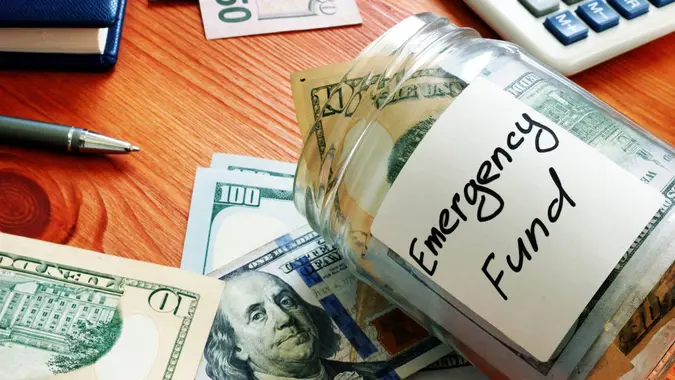Nearly Half of Americans Have Under $500 Saved in 2024 — 4 Ways To Buck the Trend

Commitment to Our Readers
GOBankingRates' editorial team is committed to bringing you unbiased reviews and information. We use data-driven methodologies to evaluate financial products and services - our reviews and ratings are not influenced by advertisers. You can read more about our editorial guidelines and our products and services review methodology.

20 Years
Helping You Live Richer

Reviewed
by Experts

Trusted by
Millions of Readers
Amid economic uncertainty and gloomy forecasts, Americans are struggling to save. A recent GOBankingRates study of 1,063 U.S. adults found that nearly half of those surveyed have less than $500 in savings, with 36% having $100 or less in savings.
While inflation has steadily improved since the June 2022 peak of 9.1%, borrowing rates and consumer prices are still much too high and real wages too low. Any windfall savings from stimulus payments have been spent long ago, causing the average American family to rely on bad credit to pay the heavy burden of necessities like food and rent.
As always, the best time to change your finances for the better is now, no matter how little the impact seems at first. It’s great to have long-term goals but if you want to buck the trend and start to grow your savings, you’re better off sticking to these four short-term savings goals before striving for overall financial wellness.
1. Start With a Small Emergency Fund
Experts are torn between prioritizing savings or paying off debt. Both can be done at the same time but if your savings are suffering, you need to at least protect yourself with an emergency fund first to deal with any unexpected expenses. Debt has to be tackled — sometimes at the expense of savings — but you need to have money available to do so.
The typical emergency fund should cover three to six months of living expenses depending on your situation. A smaller buffer could be enough if you live well below your means, however, most Americans will need more than a six-month cushion in these economic times. Achieving your emergency savings goals isn’t a race. Start small … but start!
2. Find Ways To Cut Spending
You won’t bulk up your savings without changing your spending habits, but with individuals and families putting so much money toward necessary expenses like bill, loan and debt payments, making cuts and building savings won’t be easy.
However, even with money being tight, there are ways to cut the fat. With food prices so steep, people are finding it hard to buy some items at the grocery store. However, if you want to build your savings, discretionary spending needs to be checked, on subscriptions, impulse items and even pizza.
3. Include Savings in Your Budget and Track It
Using one of the many budgeting apps or strategies — like the 50/30/20 approach or a snowball/avalanche method — can help track your money coming in and going out. But your budget doesn’t need to involve anything more than pen and paper.
Simply monitoring your monthly income minus your expenditures will make it easy to mark your progress toward your goal. And there’s no reason to exclude what you are putting into savings or an emergency fund into your budget. If saving is meaningful to you, it needs to be included in your budget.
4. Automate Transfers to a High-Interest Savings Account
Making money through investments is the best way to grow your wealth, but before you can spend money on Treasury bills and certificates of deposit (CDs), start stocking money away in a high-interest savings account and automatically transfer funds to it from your checking account each month.
As CNBC notes, savers are getting better rates today than they’ve had in years. Starting to make regular automated contributions to a dedicated savings account is what’s important, not the amount. By making a commitment to improve your finances through small-scale changes in spending and budgeting, you’ll soon find that you’ve built a significant emergency fund and more.
More From GOBankingRates
- Nearly 1 in 3 Americans Hit by a Costly Holiday Scam, Norton Survey Shows -- How To Avoid This
- Here's What the Average Social Security Payment Will Be in Winter 2025
- How Middle-Class Earners Are Quietly Becoming Millionaires -- and How You Can, Too
- The Easiest Way to Score $250 for Things You Already Do
 Written by
Written by 

























